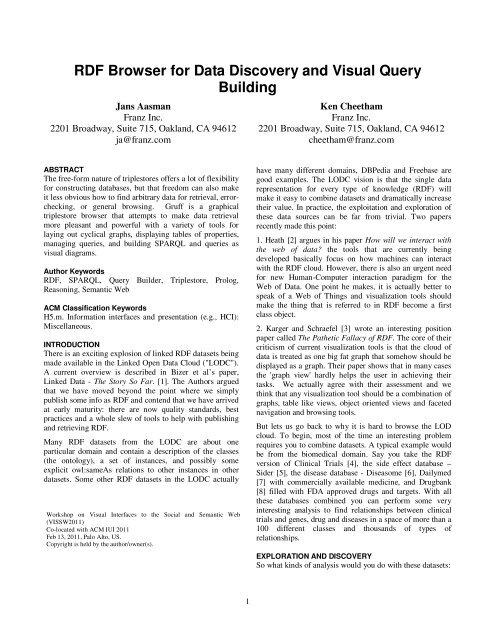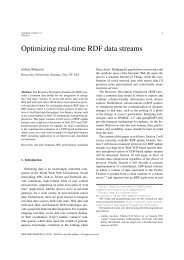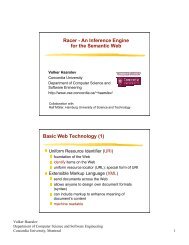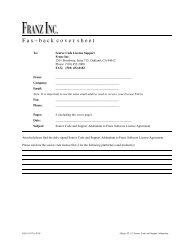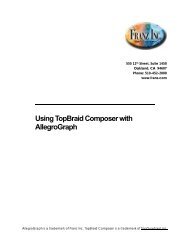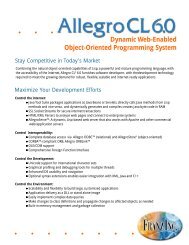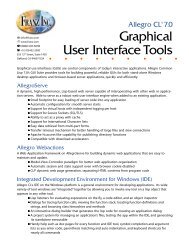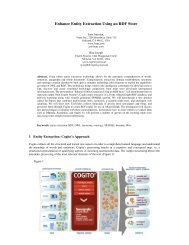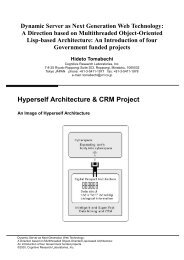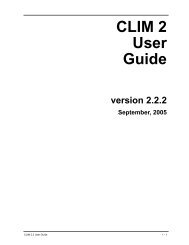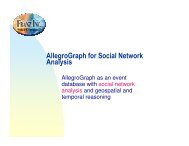RDF Browser for Data Discovery and Visual Query ... - Franz Inc.
RDF Browser for Data Discovery and Visual Query ... - Franz Inc.
RDF Browser for Data Discovery and Visual Query ... - Franz Inc.
You also want an ePaper? Increase the reach of your titles
YUMPU automatically turns print PDFs into web optimized ePapers that Google loves.
<strong>RDF</strong> <strong>Browser</strong> <strong>for</strong> <strong>Data</strong> <strong>Discovery</strong> <strong>and</strong> <strong>Visual</strong> <strong>Query</strong><br />
Building<br />
Jans Aasman<br />
<strong>Franz</strong> <strong>Inc</strong>.<br />
2201 Broadway, Suite 715, Oakl<strong>and</strong>, CA 94612<br />
ja@franz.com<br />
Ken Cheetham<br />
<strong>Franz</strong> <strong>Inc</strong>.<br />
2201 Broadway, Suite 715, Oakl<strong>and</strong>, CA 94612<br />
cheetham@franz.com<br />
ABSTRACT<br />
The free-<strong>for</strong>m nature of triplestores offers a lot of flexibility<br />
<strong>for</strong> constructing databases, but that freedom can also make<br />
it less obvious how to find arbitrary data <strong>for</strong> retrieval, errorchecking,<br />
or general browsing. Gruff is a graphical<br />
triplestore browser that attempts to make data retrieval<br />
more pleasant <strong>and</strong> powerful with a variety of tools <strong>for</strong><br />
laying out cyclical graphs, displaying tables of properties,<br />
managing queries, <strong>and</strong> building SPARQL <strong>and</strong> queries as<br />
visual diagrams.<br />
Author Keywords<br />
<strong>RDF</strong>, SPARQL, <strong>Query</strong> Builder, Triplestore, Prolog,<br />
Reasoning, Semantic Web<br />
ACM Classification Keywords<br />
H5.m. In<strong>for</strong>mation interfaces <strong>and</strong> presentation (e.g., HCI):<br />
Miscellaneous.<br />
INTRODUCTION<br />
There is an exciting explosion of linked <strong>RDF</strong> datasets being<br />
made available in the Linked Open <strong>Data</strong> Cloud ("LODC").<br />
A current overview is described in Bizer et al’s paper,<br />
Linked <strong>Data</strong> - The Story So Far. [1]. The Authors argued<br />
that we have moved beyond the point where we simply<br />
publish some info as <strong>RDF</strong> <strong>and</strong> contend that we have arrived<br />
at early maturity: there are now quality st<strong>and</strong>ards, best<br />
practices <strong>and</strong> a whole slew of tools to help with publishing<br />
<strong>and</strong> retrieving <strong>RDF</strong>.<br />
Many <strong>RDF</strong> datasets from the LODC are about one<br />
particular domain <strong>and</strong> contain a description of the classes<br />
(the ontology), a set of instances, <strong>and</strong> possibly some<br />
explicit owl:sameAs relations to other instances in other<br />
datasets. Some other <strong>RDF</strong> datasets in the LODC actually<br />
Workshop on <strong>Visual</strong> Interfaces to the Social <strong>and</strong> Semantic Web<br />
(VISSW2011)<br />
Co-located with ACM IUI 2011<br />
Feb 13, 2011, Palo Alto, US.<br />
Copyright is held by the author/owner(s).<br />
have many different domains, DBPedia <strong>and</strong> Freebase are<br />
good examples. The LODC vision is that the single data<br />
representation <strong>for</strong> every type of knowledge (<strong>RDF</strong>) will<br />
make it easy to combine datasets <strong>and</strong> dramatically increase<br />
their value. In practice, the exploitation <strong>and</strong> exploration of<br />
these data sources can be far from trivial. Two papers<br />
recently made this point:<br />
1. Heath [2] argues in his paper How will we interact with<br />
the web of data? the tools that are currently being<br />
developed basically focus on how machines can interact<br />
with the <strong>RDF</strong> cloud. However, there is also an urgent need<br />
<strong>for</strong> new Human-Computer interaction paradigm <strong>for</strong> the<br />
Web of <strong>Data</strong>. One point he makes, it is actually better to<br />
speak of a Web of Things <strong>and</strong> visualization tools should<br />
make the thing that is referred to in <strong>RDF</strong> become a first<br />
class object.<br />
2. Karger <strong>and</strong> Schraefel [3] wrote an interesting position<br />
paper called The Pathetic Fallacy of <strong>RDF</strong>. The core of their<br />
criticism of current visualization tools is that the cloud of<br />
data is treated as one big fat graph that somehow should be<br />
displayed as a graph. Their paper shows that in many cases<br />
the 'graph view' hardly helps the user in achieving their<br />
tasks. We actually agree with their assessment <strong>and</strong> we<br />
think that any visualization tool should be a combination of<br />
graphs, table like views, object oriented views <strong>and</strong> faceted<br />
navigation <strong>and</strong> browsing tools.<br />
But lets us go back to why it is hard to browse the LOD<br />
cloud. To begin, most of the time an interesting problem<br />
requires you to combine datasets. A typical example would<br />
be from the biomedical domain. Say you take the <strong>RDF</strong><br />
version of Clinical Trials [4], the side effect database –<br />
Sider [5], the disease database - Diseasome [6], Dailymed<br />
[7] with commercially available medicine, <strong>and</strong> Drugbank<br />
[8] filled with FDA approved drugs <strong>and</strong> targets. With all<br />
these databases combined you can per<strong>for</strong>m some very<br />
interesting analysis to find relationships between clinical<br />
trials <strong>and</strong> genes, drug <strong>and</strong> diseases in a space of more than a<br />
100 different classes <strong>and</strong> thous<strong>and</strong>s of types of<br />
relationships.<br />
EXPLORATION AND DISCOVERY<br />
So what kinds of analysis would you do with these datasets:<br />
1
Example 1 - Automatic <strong>Discovery</strong>. Sometimes users just<br />
want to know if it would be possible to find any connection<br />
between two interesting instances from two different<br />
datasets. A good example would be to find all the links you<br />
can find between a particular target (Cytochrome c3) <strong>and</strong><br />
say Morphine Sulfate given all the predicates or a subset of<br />
the predicates in the database. What is non-trivial about<br />
this? Well most Triplestores do not provide automatic<br />
discovery functions that would connect these instances or<br />
provide ways to specify which predicates to use while<br />
doing automatic discovery.<br />
Example 2 - Write New Queries. Say a user has two<br />
instances from two different datasets (like Example 1) <strong>and</strong><br />
you want to write a SPARQL query that links them<br />
together. Again, what is non trivial about this? In some<br />
sense a user has to know the datasets be<strong>for</strong>e they can write<br />
the queries, that is, you have to underst<strong>and</strong> the predicates<br />
<strong>and</strong> the names of the classes that will link them together.<br />
Un<strong>for</strong>tunately the datasets from the example above lack<br />
domain <strong>and</strong> range restrictions so it not straight <strong>for</strong>ward to<br />
explore the schema space. Additional usability problems are<br />
that you have to know the namespaces, the fragments of the<br />
namespaces, <strong>and</strong> very often the type of the objects.<br />
Example 3 - Basic <strong>Data</strong> Mining: Say you have an instance<br />
of a clinical trial <strong>and</strong> now you want to find all the clinical<br />
trials that discuss the same kind of drugs, diseases <strong>and</strong><br />
targets. The non trivial part is that most triple stores do not<br />
offer you advanced ways to per<strong>for</strong>m stored procedures on<br />
large datasets that could do this data mining <strong>for</strong> you.<br />
In order to make exploration of multiple datasets easier we<br />
developed Gruff, an advanced Graphical User Interface <strong>for</strong><br />
working with <strong>RDF</strong> <strong>Data</strong> in a triplestore.<br />
Gruff provides a full set of graph analysis capabilities to<br />
help users explore the LODC. In the most simple case a<br />
user selects two resources in Gruff, the predicates the graph<br />
algorithm needs to explore, <strong>and</strong> Gruff will find all<br />
connections between the two instances. The end result on<br />
the screen can even be saved as an NTriple file. The graph<br />
algorithms all take as input first class functions called<br />
generators. The contract <strong>for</strong> a generator is that it takes one<br />
node as an input, <strong>and</strong> will generate a set of nodes as output.<br />
Gruff will create these generators <strong>for</strong> you if you select the<br />
predicates that you want to explore.<br />
In other cases the users want to investigate something more<br />
sophisticated, like conditionally exploring predicates per<br />
type of node (or resource), starting with the important<br />
predicates first. In this case the user needs to write some<br />
SPARQL or Prolog code <strong>and</strong> this can be facilitated with the<br />
visual query builder described below.<br />
With Gruff you can first explore the graph over multiple<br />
link data sets completely visually, <strong>and</strong> once you find one<br />
pattern that you are interested in, you can easily build from<br />
that a visual query <strong>and</strong> find all the same patterns in the set<br />
of linked datasets.<br />
Gruff provides several key capabilities <strong>for</strong> LODC<br />
exploration:<br />
Graph Layout:<br />
Triplestores specialize in relationships between things, <strong>and</strong><br />
it can be difficult to get a feel <strong>for</strong> a tangled set of<br />
relationships.<br />
Gruff's Graph View (figure 1) provides automatic layout of<br />
highly-cyclic graphs. Heuristics are used to make layouts of<br />
a modest number of nodes fast enough <strong>for</strong> interactive<br />
browsing. The algorithm specializes in keeping nodes from<br />
laying on top of unrelated link lines, even though all link<br />
lines are straight; those two features allow you to quickly<br />
spot all of the nodes that are linked with a particular node,<br />
<strong>and</strong> then to quickly spot all of the linked nodes of those<br />
nodes, <strong>and</strong> so on.<br />
Figure 1.<br />
Once you have found one or more initial objects of interest,<br />
the familiar Table View (figure 2) can be used to jump to<br />
linked objects that are properties of other objects. The<br />
Graph View will add nodes <strong>and</strong> links that show a history of<br />
all of the paths that you traversed in the Table View. You<br />
can also incrementally add linked nodes directly in the<br />
Graph View.
Gruff's newest feature, the Graphical <strong>Query</strong> View (figure<br />
3), allows creating queries as diagrams of nodes <strong>and</strong> links.<br />
A query diagram can include actual objects from the store,<br />
which you select as in other views, while other nodes <strong>and</strong><br />
links represent query variables. Group graph patterns such<br />
as UNION <strong>and</strong> OPTIONAL groups can be laid out as<br />
grouper boxes that can be nested to any level, with proper<br />
nesting maintained automatically.<br />
Figure 2.<br />
Finding arbitrary objects:<br />
A triplestore can contain many objects that are not instances<br />
of a simple set of classes, <strong>and</strong> so it can be tricky to locate<br />
arbitrary objects of interest.<br />
Gruff has a variety of ways <strong>for</strong> looking up arbitrary objects.<br />
These include (1) specifying an object textually as either its<br />
easy-to-type rdfs:label string, its full URI, or a brief URI<br />
that uses a namespace identifier; (2) selecting a node that<br />
has a selected rdf:type (selecting the type either from a<br />
single list or from an rdfs:subClassOf hierarchy); (3)<br />
finding all nodes that have property values containing<br />
arbitrary text, using free text lookup; <strong>and</strong> even (4) selecting<br />
from all sorted nodes.<br />
When there are many choices to select from, Gruff manages<br />
the selection by using a series of pop-up menus that allow<br />
you to gradually hone in on a desired object. You use these<br />
menus by first selecting the starting character of an object's<br />
name, then the second character, <strong>and</strong> so on. Each menu<br />
displays only the choices that remain <strong>for</strong> the next character,<br />
with string completion <strong>for</strong> the remaining choices to the<br />
extent that's possible without ambiguity, allowing you to<br />
see increasingly recognizable choices.<br />
Saving visual layouts <strong>and</strong> other views to file allows you to<br />
start back up quickly in a future Gruff session with a<br />
familiar set of "starter nodes", rather than specifying them<br />
again from scratch. The most recently saved or loaded<br />
views are always listed on the View menu <strong>for</strong> quick<br />
retrieval. You can also copy nodes from one view to<br />
another, <strong>for</strong> example, to avoid respecifying them.<br />
Building Queries Graphically<br />
While query languages like SPARQL are quite powerful,<br />
queries can become rather complex <strong>and</strong> there<strong>for</strong>e difficult<br />
to construct free of nesting mismatches <strong>and</strong> typos in URIs.<br />
Figure 3.<br />
Once you've created a query diagram, Gruff will generate<br />
either SPARQL or Prolog code <strong>for</strong> the query. Seeing the<br />
generated query text (figure 4) can help you learn to write<br />
SPARQL or Prolog queries directly. You can also edit the<br />
generated text be<strong>for</strong>e per<strong>for</strong>ming the query. You can save<br />
queries either as graphical diagrams or as actual query text<br />
<strong>and</strong> load them any time later <strong>for</strong> modification into related<br />
queries. You can even generate a visual graph from query<br />
results, showing the network of all triples that are<br />
comprised of nodes <strong>and</strong> predicates that are in the query<br />
results <strong>and</strong> the query itself.<br />
Figure 4.<br />
3
CONCLUSION<br />
In general, Gruff's tools are tightly integrated to allow<br />
browsing a triple-store in a variety of ways. Gruff is free<br />
<strong>and</strong> can be downloaded from www.franz.com/agraph/gruff/,<br />
where additional screen shots <strong>and</strong> demonstration videos can<br />
also be found.<br />
REFERENCES<br />
1. Heath, T., Hepp, M., <strong>and</strong> Bizer, C. The Story So Far.<br />
Special Issue on Linked <strong>Data</strong>, International Journal on<br />
Semantic Web <strong>and</strong> In<strong>for</strong>mation Systems (IJSWIS) 2009.<br />
http://linkeddata.org/docs/ijswis-special-issue<br />
2. Tom Heath (2008) How Will We Interact with the Web<br />
of <strong>Data</strong>? IEEE Internet Computing, Vol. 12(5), pp. 88-<br />
91<br />
3. Schraefel, M. <strong>and</strong> Karger, D. (2006) The Pathetic<br />
Fallacy of <strong>RDF</strong>. In: International Workshop on the<br />
Semantic Web <strong>and</strong> User Interaction (SWUI) 2006, Nov<br />
2007, Athens, Georgia.<br />
4. LinkedCT http://linkedct.org/index.html<br />
5. Sider - http://sideeffects.embl.de/<br />
6. Diseasome - http://www.nd.edu/~alb/Publication06/145-<br />
HumanDisease_PNAS-14My07-Proc/Suppl/.<br />
7. DailyMed - http://dailymed.nlm.nih.gov/<br />
8. Drugbank - http://www.drugbank.ca/


